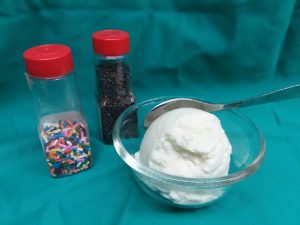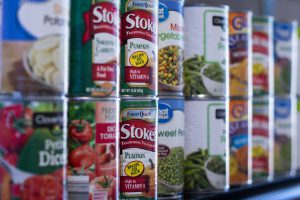
by Claire Davis | Jul 1, 2022
July is one of my favorite months of the year. Summer is in full swing, school is out, temperatures are soaring, and we celebrate Independence Day, as well as my birthday! While all those things are great, my favorite part about the month is celebrating National Ice Cream Month all month long! Who wouldn’t love a cold, sweet treat on a hot, summer day?
Did you know that one 1/2 cup serving of regular ice cream is considered a good source of calcium and phosphorous, containing 10% of the recommended daily value? While ice cream can be part of a balanced diet, its high calorie and fat content are something to consider. Ice cream is good in moderation, something I know I struggle with.

Cold, Delicious, and so many flavors! Photo source: Lyndsey B.
One of my favorite things about ice cream is the options are endless. Not only are there numerous flavors to choose from, but there are other options for how it can be made or served. “Add-ins” such as berries, chocolate sauce, sprinkles, and whipped cream can change how the base ice cream tastes. Some of the most popular flavors, such as vanilla, chocolate, cookie dough, strawberry, butter pecan, etc., do not need any add-ins though.
Types of ice cream also can be broken down into different categories:
- Regular ice cream is a frozen food product made from dairy products with at least 10% milk fat.
- Light ice cream contains at least 50% less fat or 33% fewer calories than regular ice cream.
- Low-fat ice cream contains no more than 3 grams of fat per serving.
- Nonfat ice cream contains less that 0.5 gram of fat per serving.
- Frozen custard, also known as French ice cream, contains a minimum of 10% milk fat as well as 1.4% egg yolk solids.
- Sherbets have a milk fat content only between 1-2%.
- Sorbet, also known as water ices, are similar to sherbet, but do not contain dairy.
- Frozen yogurt has a mixture of dairy ingredients such as milk or nonfat milk that has been cultured, as well as other ingredients for sweetening and flavoring.

Enjoy a scoop of ice cream in honor of National Ice Cream Month.
Photo source: UF/IFAS Northwest District
Since the kids are home from school, I am always looking for activities for them. Check out the recipe and instructions below for how to make your own ice cream in a bag at home!
Ingredients:
- 3 Zip-top bags: 2 quart-size and 1 gallon-size
- ¼ c. cream
- ¼ c. milk
- 1 Tbsp. sugar
- 3/4 tsp. vanilla extract
- 4-5 c. ice
- 1/3 c. salt (rock salt or large granules works the best)
- Toppings of your choice (sprinkles, chocolate syrup, fruits, whipped cream, etc.)
Directions:

A cool and refreshing sweet treat
Photo Source: Angela Hinkle
- Bag it! In a quart Zip-top bag, combine cream, milk, sugar and vanilla. Push out excess air and seal. (Double bag it to avoid spillage)
- Ice it! Add the ice and salt into the gallon zip-top bag. Then place the smaller, sealed bag into the ice.
- Shake it! Seal the bag and shake vigorously, 7 to 10 minutes. Do this until the ice cream has hardened. The more you shake, the quicker it hardens.
- Remove it! Remove the smaller bag from the big bag. Throw the big bag away.
- Top it! Either eat the ice cream out of the bag or spoon it into a bowl. Add your favorite toppings and enjoy!
Source:
https://fsi.colostate.edu/ice-cream/

by Heidi Copeland | Jul 1, 2022

Stock up on canned fruits, vegetables, meats, and heat-and-eat soups for your hurricane food supply kit. Photo source: UF/IFAS Photo by Tyler Jones.
Even during hurricane season. Yes, the Atlantic hurricane season starts on June 1st and runs through November 30th every year. August and September are usually the busiest hurricane months in Florida. It is tempting to believe that danger will not be coming our way, however, the Sunshine State has already experienced Alex. Bonnie, Colin, Danielle… are sure to follow.
Planning for hurricane preparation takes time and money, however, planning can save you both time and money. Know, too, that your hurricane planning can accommodate other emergencies.
The Department of Homeland Security’s Build A Kit | Ready.gov suggests having enough provisions for two weeks in your basic emergency kit, whereas other sources state three days. Since Spring 2020, the Centers for Disease Control and Prevention (CDC) has recommended people include additional items in their kits to help prevent the spread of coronavirus or other viruses and the flu. (And don’t forget sanitation supplies and personal hygiene items. Poor hygiene can help spread disease, too).
A central step in planning for emergencies is to take advantage of what you have on hand and be mindful when adding to it. Taking an inventory of what you have is an important tool in managing personal resources. From your inventory, make a list of what you need to purchase. When shopping for nonperishable hurricane food items and supplies, use your list and stick to it. Adding a few items to each shopping trip can help spread the cost burden of stocking up on emergency supplies.
Being prepared means having your own food, water, and other related supplies (think home, yard, and even car). Now is also a good time to eat what is in your freezer (think power outages – frozen food has a time limit if your power goes out) and take stock of your pantry. It makes economic sense to plan to use what you have (think expiration dates – rotating pantry supplies), supplemented with nutritious, stocked hurricane supplies.
Additionally, one half of people in the United States take medication. Planning in advance for medical needs is as imperative as planning for food and other safety equipment.
Waiting until an announced, named storm hits the radar is often the wrong time to start your emergency preparation. Prices might be higher, and supplies might be harder to find. Plan and prepare now for whatever emergency may come your way. Personally, I went thirty years without needing anything but a flashlight on occasion to being without power for eight days during Hurricane Michael. Others in my area fared far worse.
Whether we want them or not, emergencies happen. Planning for one can save you both time and money.
Pantry Prep: Stock Up for Emergencies (English)
Pantry Prep: Stock Up for Emergencies (Spanish)
Prepare for Hurricane Season by Stocking up on Plenty of Non-Perishable Foods

by Gretchen Thornton | Apr 28, 2022
You play a significant role in loving your heart by developing a healthy lifestyle that will last a lifetime. Do you know a heart beats about 2.5 billion times over the average lifespan? The heart’s never-ending workload is like a love between a mother and her daughter. A mother and daughter will have bumps during their lifespans, such as teenage rebellion, a fight for independence, and the battle to become a woman. The love for your heart can also have bumps during your lifespan, such as poor diet, lack of exercise, smoking, unlucky genes, and much more.
As human beings, we all have our favorite go-to food or foods. My mother and I love to eat chips. We need to focus on eating various healthy foods. MyPlate can show how everybody can make food choices for a healthy diet. Each food group provides energy and almost every nutrient we need. No one food group is more important than the other. For good health and proper growth, individuals need to eat various types of food every day. By eating healthy, you love your heart. My mother and I should replace the chips for fruits during the day for a healthy snack.
Exercising is an essential step in loving your heart. When I was growing up, my mother and I would clean the house on Saturday mornings. The fun thing about cleaning was listening to a favorite song while dancing in the living room. Physical activities are a great tool to help you stay active during your lifespan. A person should aim for 30 minutes of moderate physical activity each day. Young children should participate in 60 minutes of physical activity a day. In 2022, love your heart by “KEEP MOVING!” and check out the Let’s Walk Florida program at your local Extension Office.
Atherosclerosis is a condition in which your arteries narrow and harden due to the buildup of fats in the artery wall. There are chemicals found in tobacco smoke that can harm your blood cells. The chemicals can damage the function of your heart and blood vessels. When this happens, you do not love your heart, and you can risk atherosclerosis. I will say, my mother and other family members are tobacco users. Each year, over 1 million Americans quit smoking. You can use many strategies to stop using tobacco, such as going to a behavior support group, breathing exercises, healthy snacks, remembering your smoking triggers, and remembering that you are saving money. Reminder: give your heart a huge hug by stopping using tobacco.

The Love for a Mother through Heart Surgery. Photo source: Gretchen Thornton
Do you know that many types of heart disease are passed down through the “Family Tree?” Heart disease can affect the heart muscle and electrical system and cause high cholesterol levels. There is much to learn about the connection between genes and heart disease within a family. Researchers continue to learn about the outcomes of the connections between the two. Communication is an essential tool to keep your family tree healthy. My mother had a heart attack when she was 60 years old. She went to the hospital for a low oxygen level due to allergies. The doctor noticed that she had a heart attack in her past. She has a pacemaker and cardioverter-defibrillator to help with her heart rhythm now. During this stage of my life, I make sure that I schedule my yearly wellness check doctor’s appointment. Love your “Family Tree” by communicating about your health history because your family grows from the same seed.
You may think it is too early to think about heart health in children. Heart disease can start early in life. A healthy lifestyle can decrease the risk of developing cardiovascular disease later in life. A child that is living a healthy life can listen and participate in school, sleep at night, have healthy bones and muscles, increase self-esteem, and adopt a lifelong habit.
Loving your heart may not be straightforward at times. A healthy lifestyle is a day-to-day process that takes time and hard work. Loving your heart is unique because we all share the same common goal to live a healthy life. In 2022, remember to follow MyPlate.gov and eat healthily. Each day, turn the television off and exercise for at least 30 minutes. Make this year tobacco-free; learn the benefits of quitting by contacting Tobacco Free Florida for more information. Spending time with your family is an excellent time to communicate about family health history and genetics. For more information about heart health, contact your local doctor about how you can become more heart-healthy.
Resource:
FSHN20-56/FS426: Reducing Your Risk for Heart Disease: The Power of Food (ufl.edu)
References:
Genetics of Congenital Heart Disease | Circulation Research (ahajournals.org)
Tobacco Free Florida | Smoking Cessation Information & Programs

by Laurie Osgood | Apr 28, 2022
National Fair Housing Month supports affordable housing by helping make affordable housing a reality for many working families, representing many backgrounds, races, and colors. The Fair Housing Act was enacted into law in 1968 to protect Americans from discrimination when selling or buying houses, including rental properties and mortgage financing, based on color, race, and even gender. According to the Fair Housing Amendments Act, it is illegal to discriminate against any person because of race, color, religion, sex, handicap, familial status, or national origin.
The Fair Housing Act protects consumers from following unlawful, discriminatory housing practices in:

The Fair Housing Act protects buyers and renters from discriminatory housing practices. Photo Credit: Pam Tribue, UF/IFAS Extension Gadsden County.
- the rental or sale of housing properties, including residential lots
- the establishment of real estate brokerage services
- the marketing or advertisement of properties for sale or rent
- the appraisal process of housing properties
- the housing finance process
Marcia L. Fudge, Secretary, Department of Housing and Urban Development (HUD), states that “Fair Housing Month is a time to recommit to our nation’s obligation to ensure that everyone has equal access to safe, affordable housing. Unfortunately, housing discrimination still exists, from individuals and families being denied a place to call home because of the color of their skin or where they come from, to landlords refusing to allow persons with disabilities to keep assistance animals, to individuals being denied a place to live because of who they love.”
Are you a victim of unlawful housing discrimination?
Anyone who believes they have suffered unfair housing practices or discrimination can file a complaint with HUD’s Office of Fair Housing and Equal Opportunity at (800) 669-9777. You can also report housing discrimination online by using the following link: https://www.hud.gov/program_offices/fair_housing_equal_opp/online-complaint#_How_to_File
To learn more about Fair Housing, contact UF/IFAS Extension Gadsden County at (850) 875-7255.
Source:
HUD Commemorates National Fair Housing Month 2022 | HUD.gov / U.S. Department of Housing and Urban Development (HUD)

by Gretchen Thornton | Apr 25, 2022
Did you know that all-terrain vehicle (ATV) injuries went up 50% from 1982 to 2017? ATVs have increased in popularity here in the United States and worldwide. The products are great if used appropriately. Nearly 75% of the accidents result in brain and spinal cord injuries. Many parents ask the common question, “How can we make ATV riding safe for everyone?” The main goal for ATV riding is for each rider to have their best, and safest, possible riding experience.

ATV riders should wear protective equipment and carefully follow the manufacturer’s guidelines for safe operation. Photo source: UF/IFAS.
When the ATV is purchased, the buyer and rider must follow the manufacturer’s guidelines. First, make sure there is an operator’s guide with the product when it is purchased. The buyer needs to ensure everyone reads and follows the operator’s guide. It is a good idea to read the operator’s guide when seated on the ATV so the rider understands the controls and how they work. The rider and any passengers need to read the safety warning label on the ATV. The label specifies the age recommendation for the rider. Reminder: Nobody of any age should ride an ATV if they cannot be responsible. Parents need to ensure the child is age-appropriate for that ATV, receives proper training and instructions, and takes an approved riding safety course. Parents should never leave a child alone, especially when the child is operating an ATV.
The rider should be familiar with the surrounding terrain where the ATV will be driven. The rider should reach all controls, sit correctly, and reach the foot rest on the ATV. The rider must avoid anything that impairs their abilities.
Second, the rider needs to do a pre-ride inspection. Before each ride, the rider should inspect the ATV to ensure the vehicle is in good condition. The rider can find the pre-ride inspection information in the operator’s guide. The rider can contact the local dealership if there is a problem with the ATV.
Third, the rider needs to wear protective gear on an open-air vehicle. The protective gear includes an approved helmet, eye protection, closed-toe footwear/over-the-ankle boots, long pants, long sleeve shirt, full-fingered gloves, and rain gear, if needed.
Fourth, the rider should understand the rules for riding with passengers. The rider should never carry passengers in the cargo area. The passenger should review the manual and safety labels on the ATV before riding. Passengers must sit up correctly while placing their feet flat on the footrests, and hold onto the handhold device. Hand guards can be added to the ATV to provide additional protection. If the rider is not advanced, he or she should not ride with a passenger.
Fifth, the rider should understand the stability of the ATV. ATVs are easy to roll or tip over quickly when riding. The rider should never attempt maneuvers that can be dangerous to the rider or the passenger.
Sixth, turning the ATV too fast or sharp is the leading cause of accidents. The rider needs to pay attention to the movement of the ATV when turning and shift their weight accordingly. The passengers also need to pay attention to the road, lean with the rider, and keep their hands on the handhold device.
Seventh, braking the ATV is very important to the rider. The proper way to stop the ATV is found in the operator’s guide. The weather and terrain can affect the braking distance when riding. The rider needs to adjust their driving according to the towing, weight, and equipment on the ATV.
There are more components to learn about ATV Safety including reversing, carrying cargo, and understanding the terrain. For more information about ATV safety and product inquiry, contact your local ATV store.
For more information, visit:
ATV Safety | 4-H in the Panhandle (ufl.edu)
ATV Safety – Safety Rules for ATV Riding | Kids and Adults
OHV Safety / Off-Highway Vehicles (OHV) / State Forest Recreation / State Forests / Our Forests / Forest & Wildfire / Home – Florida Department of Agriculture & Consumer Services (fdacs.gov)

by Samantha Kennedy | Apr 22, 2022

Prudence Caskey, Santa Rosa County 4-H Agent. Photo source: UF/IFAS
Written by Prudence Caskey, Extension Agent II – 4-H Youth Development, UF/IFAS Extension Santa Rosa County
The hot Florida summer is approaching, and we all need to make sure we focus on hydration in the heat. Dehydration is very common in hot, humid environments. Many people do not drink the recommended amount of water. Many of us have our coffee in the morning and unless we go out to lunch and someone gives us water, we seldom think about water during the day. Another confusing concept is how much water we should drink. Growing up, we were told to get eight glasses of water a day. That is 64 ounces. Let’s see if that adage still holds true today.
How much water should I drink?
The best way to calculate how many ounces of water to drink is to multiply your weight by .67 or 67%. For example, a person weighing 150 pounds would need 100½ ounces or a little over 12½ cups. On the other hand, a person weighing 200 pounds would need 134 ounces or 16¾ cups.
Is that all the water I need?
No, as you sweat, you lose the water you have already consumed. If you are sweating for 30 minutes, you need to replenish your hydration with 12 additional ounces of fluid.
What fluid should I drink?
The main thing to remember when it comes to hydration is, just because it is wet does not mean you are being hydrated. Different fluids are absorbed by our bodies differently. Some alcoholic beverages remove hydration from our bodies as we drink them. Below is an example of how our bodies absorb some common beverages:
- Water absorbed at 100%
- Sparkling Water absorbed at 100%
- Skim Milk absorbed at 90%
- Buttermilk absorbed at 90%
- Whole Milk absorbed at 80%
- Apple Juice absorbed at 88%
- Decaffeinated Coffee absorbed at 90%
- Coffee absorbed at 80%
- Sports Drinks absorbed at 50%
- Energy Drink absorbed at 40%
- Wine absorbed at negative 150%
- Beer absorbed at negative 60%
- Sake absorbed at negative 180%

Staying hydrated in the heat of summer is an important part of sun safety. (Photo source: UF/IFAS File Photo)
- Liquor absorbed at negative 300%
This is a huge concept to grasp if you plan on being out at the beach with your friends this summer. With this example, a well-hydrated 150-pound person consumes the required 100½ ounces of fluid. Then, at a gathering, they have three glasses of wine. The standard five ounces per glass would mean they have removed 22½ ounces from their hydration after drinking only 15 ounces of wine. Be cognizant of what you add to your coolers this year.
What are the signs of dehydration?
There are many signs our bodies will give us to signal dehydration. Headache, nausea, and muscle pains are common. However, the most common sign of dehydration is thirst. That’s right, if you are thirsty, it is your body’s way of letting you know you need fluids. Just be careful which fluids you choose this summer when you are out enjoying the Florida sun.
Learn more at: https://edis.ifas.ufl.edu/publication/FY1409
UF/IFAS is an Equal Opportunity Institution.















